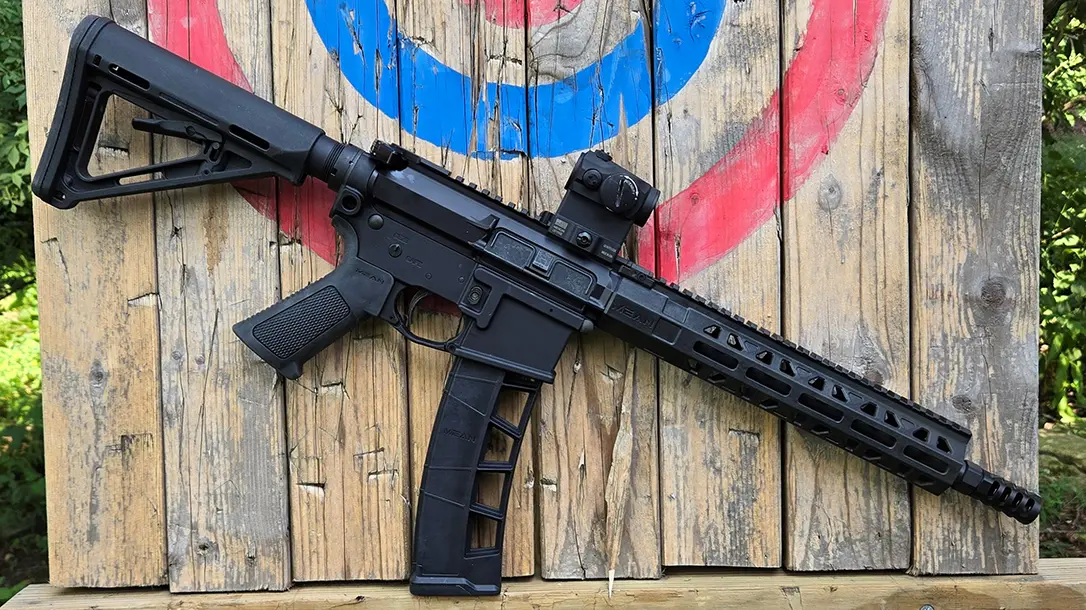Pistol caliber carbines (PCC) in 9mm have become immensely popular in recent years. They’re easy to shoot, and 9mm is fairly affordable. While there are a lot of PCC options available, the AR platform remains the most popular choice. With millions of ARs already in circulation, it makes sense to make it easy to convert your rifle caliber AR to 9mm to take advantage of the ammo savings. The MEAN Arms Bearing Delay Upper does that and more.
MEAN Arms Bearing Delay Upper for PCCs
MEAN Arms has over 50 years of manufacturing experience and does OEM work for many other companies. They aren’t new to the 9mm AR game either. They’ve been making the 9mm Endomag for a number of years now, and more recently the Exomag.
The Endomag is a conversion kit for Gen 2 and later PMAGS that allows you to use your rifle caliber AR lower with a 9mm upper without the need of adding a mag well adapter to accept pistol or SMG mags. The Exomag is a dedicated 9mm magazine that works in a standard magazine well.
Advertisement — Continue Reading Below
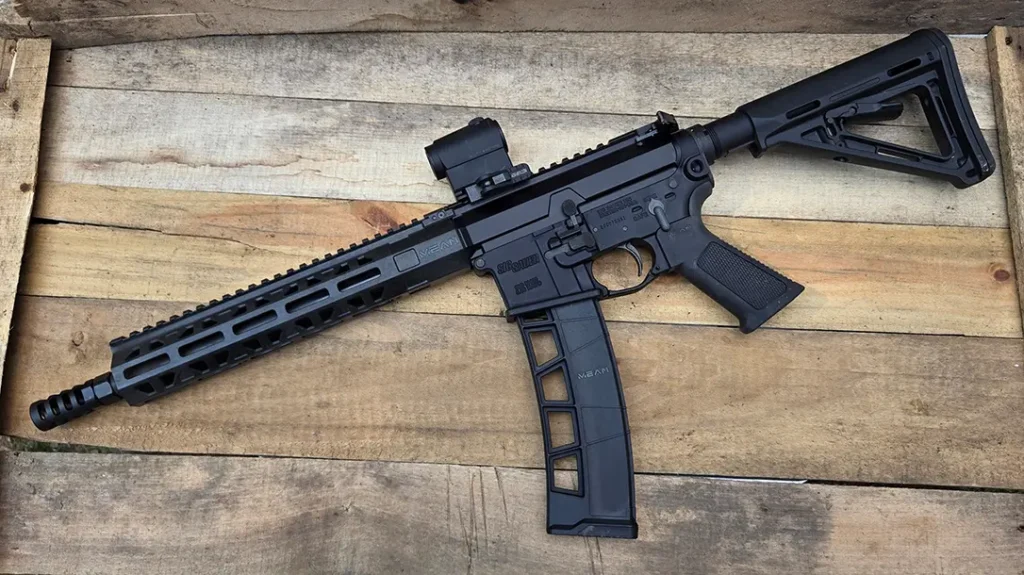
Having correct magazines is only half the battle in converting your rifle caliber AR to 9mm. If you drop a traditional 9mm AR upper on your rifle lower, you also need to swap out the buffer assembly. Being a blowback system, the 9mm needs a heavier buffer to properly operate as compared to a gas operated rifle upper.
So if you’re trying to switch back and forth between calibers, you need to swap uppers, have the right mags, and also remember to change out your buffer every time you go back and forth.
Advertisement — Continue Reading Below
Easy Swap Solution
MEAN Arms wanted a solution that allowed users to swap out easily and take advantage of the low recoil and inexpensive ammunition of 9mm, while still letting end users leave their rifle lower set up as is. This was a particular concern for law enforcement agencies who wanted to use 9mm for training for costs, or for use on indoor ranges, but then easily switch back to 5.56mm for patrol.
There’s no way around that buffer swap with a traditional blowback upper, so MEAN Arms didn’t go that route. Instead they designed their Bearing Delay Upper as a drop in conversion for existing AR lowers.
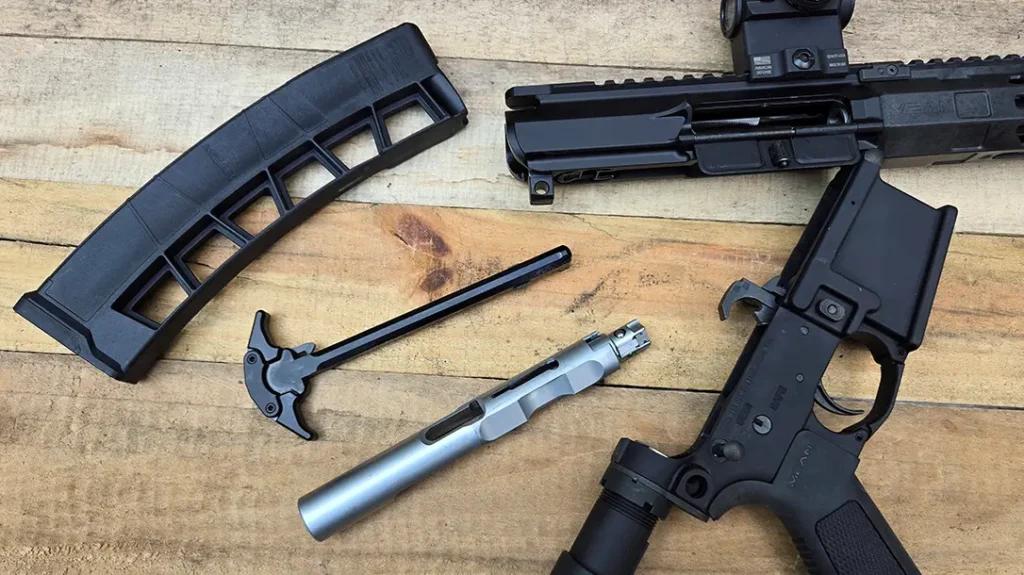
Advertisement — Continue Reading Below
The Bearing Delay Upper
I’m going to start off by saying I’m a cop, and not an engineer, so I’m going to try and keep this simple for my sake, if not yours. In a blowback system the weight of the buffer and buffer spring tension are what keeps the bolt in battery when you fire a round. You need enough weight to hold that bolt in place long enough for pressures to drop off, and for the action to cycle safely.
Aside from the need to swap out your buffer to get that weight, a heavier buffer also translates into more recoil impulse. It’s more mass being driven backwards, which translates into more felt recoil for the shooter and more movement of the gun.
With the delayed bearing action of the MEAN upper, you negate the need for the heavier buffer. The bearing system keeps the breach closed mechanically until it’s safe to cycle, so you aren’t relying on mass alone for that.
Advertisement — Continue Reading Below
Aside from doing away with the need to swap out the buffer to change to 9mm, you also get a few other advantages. Since you aren’t throwing as much mass around, you end up with a smoother shooting, lighter recoiling system.
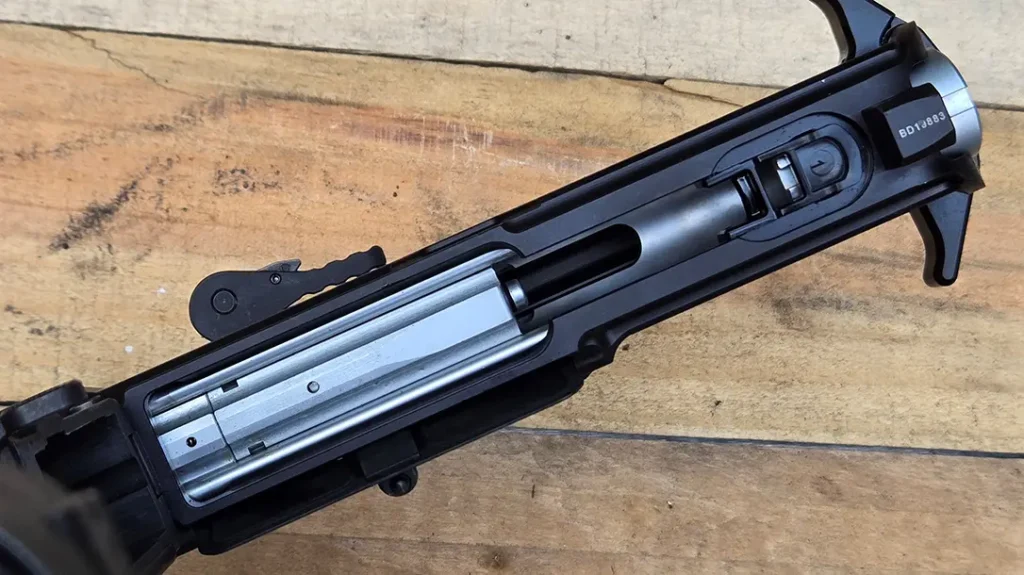
RTFM: It’s Worth It
When it comes to adding a MEAN Bearing Delay Upper to your lower, the basic install is simple. Just pop out the take down pins and remove your existing upper, and replace it with the MEAN. The MEAN works with either Endo or Exo mags, so no magazine well conversion is needed. That’s really all you need to do. No further changes or disassembly are required.
Advertisement — Continue Reading Below
With that said, I still recommend reading the manual. For one thing, it is literally the best written firearms manual I’ve seen shipped with a gun. It’s extremely detailed, and more in line with a full armorer’s manual than the simple user manual that you’d expect to see.
The other important aspect it covers though is ammunition choice. The MEAN Bearing Delay Upper comes with an installed “lifter” that should work with the majority of common 9mm ammunition loads. The lifter is the bolt component that provides the proper timing for the bolt to cycle. Depending on your barrel length and ammo choice though, you may need to swap that out. MEAN ships their upper with a second lifter, and offers additional ones, that allow you to tune the upper to your use. There’s a very good chart provided that covers which lifter will work best with each barrel length and ammo combination. Swapping them out is also covered in the manual.
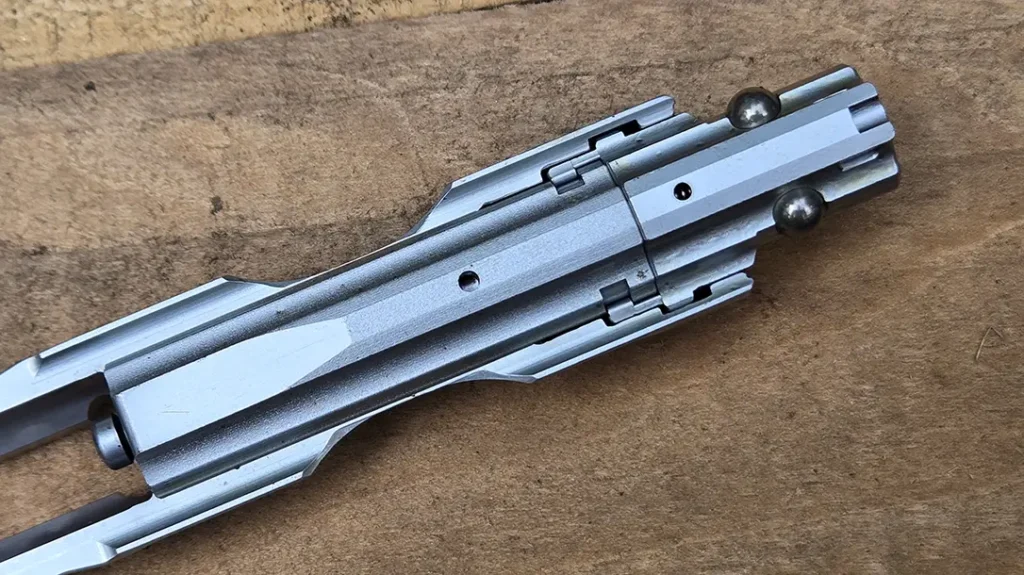
Advertisement — Continue Reading Below
Bearing Delay Upper Details
The MEAN Bearing Delay Upper is offered in a number of barrel lengths. I chose an 11-inch barrel for my testing, as I had a number of SBR lowers that I could use as a test platform. They also make 4.5, 7.5, 14.5, 14.5 with a pinned and welded muzzle device, and 16-inch uppers.
I opted to use my SIG M400 lower since that was my old work patrol rifle. Being that one of the purposes of the MEAN upper was to make police training easier and more affordable, that seemed like an appropriate choice.
The MEAN Bearing Delay Upper has a flat top with Picatinny rail. It’s a slick-side configuration without forward assist or brass deflector. Internally it differs from a standard AR upper in that it has a rail system for the bearing delay bolt carrier group to ride on. The carrier itself is a good bit different from a standard blowback AR Bolt Carrier Group (BCG) and the two are not interchangeable. The charging handle is an ambidextrous, extended model of MEAN design.
Advertisement — Continue Reading Below
The MEAN upper does not use a fixed ejector like most PCC’s. Typically an AR-based PCC needs a fixed ejector that is mounted in the lower receiver. Since the MEAN upper incorporates its own ejector into the bolt, it can be used with a standard rifle lower.
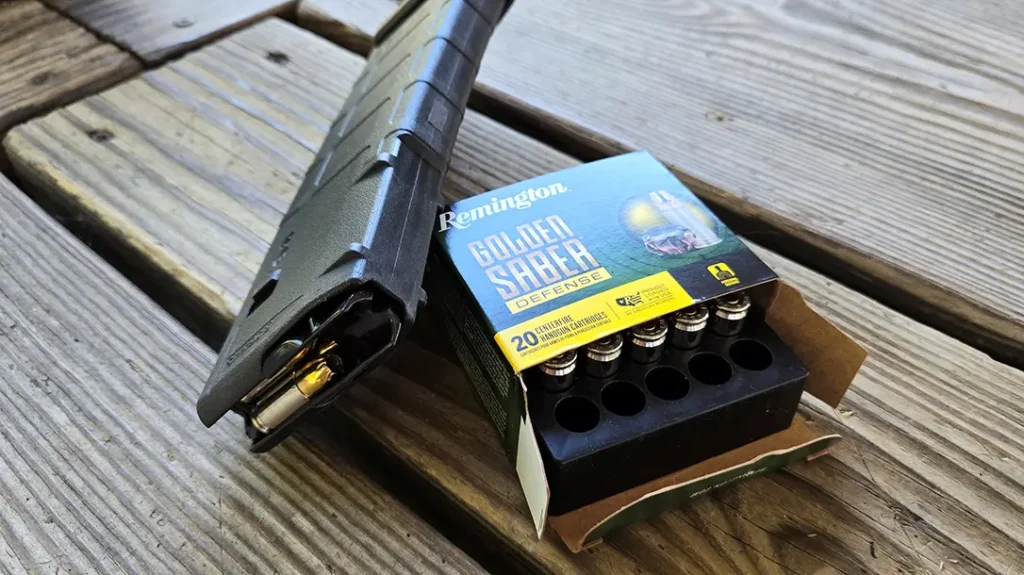
PCC Lower Compatibility
You can drop a MEAN upper on a dedicated pistol caliber lower as well. If you wanted to use the Bearing Delay system with a lower that uses Glock or Colt SMG mags, that’s entirely doable. You do have to remove the existing ejector from your PCC lower however, since the MEAN doesn’t use it.
Advertisement — Continue Reading Below
The handguards are also MEAN’s own design. They’re made of a lightweight polymer. They have a full-length Picatinny rail on top, and M-LOK attachment slots at the 3, 6 and 9 o’clock positions. They’re extremely solid and feature anti-rotation tabs.
The muzzle brake on the Bearing Delay Upper is a compensator type, and is again from MEAN Arms. Unlike a lot of companies that offer uppers or complete guns built from aftermarket parts, MEAN Arms manufactures all of the key components of their platform.
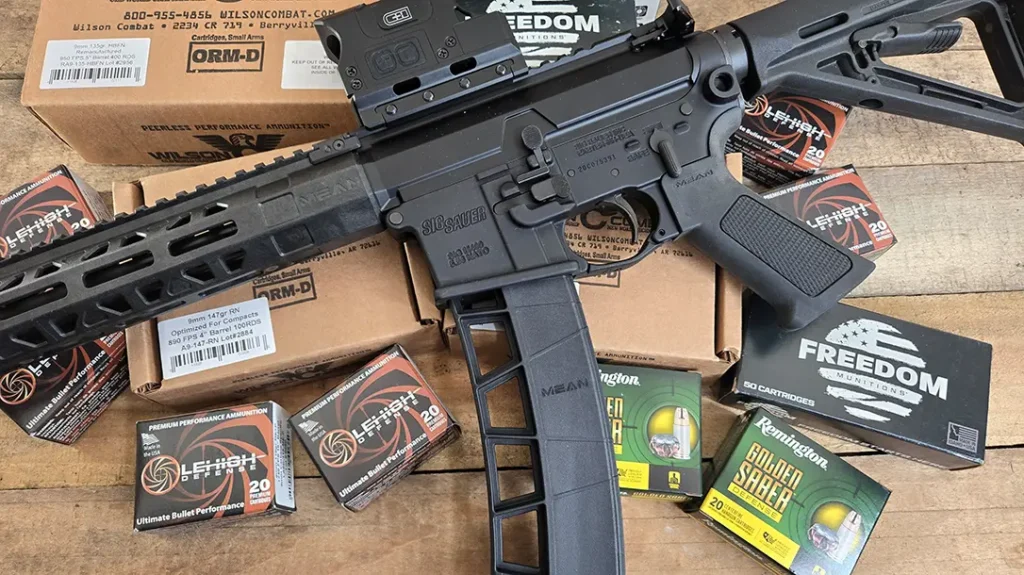
Function and Range Time
Functionally, the MEAN Upper operates just like any other AR, which is the point. MEAN wanted folks using their upper as a training device to have it work seamlessly with the host receiver platform.
Since the MEAN upper works with either the Endo or Exo mags, that also makes magazine changes the same as using your rifle caliber mags. You can also use your existing magazine pouches as well, for continuity of training.
I ran a variety of 9mm rounds through my MEAN upper over three range sessions. During the first session, I borrowed my Aimpoint T1 from my SIG upper and grabbed some random 9mm ammo from my personal stash. I had some inexpensive 124-grain ball from Igman, as well as an old box of 124-grain Peruvian military surplus ammo. Since I hadn’t read the manual yet, I didn’t realize that MEAN doesn’t recommend crusty surplus ammo. Despite that, everything ran just fine. I also tried some Winchester 147-grain FMJ and 147-grain Speer Gold Dot hollow points. The MEAN ate it all without a hiccup.
The MEAN upper was like shooting a laser at 30 yards and under. Drop the dot on target, pull the trigger and get a hit. All with the kind of boring repeatability you want in a rifle that you might consider using for defense or competition.
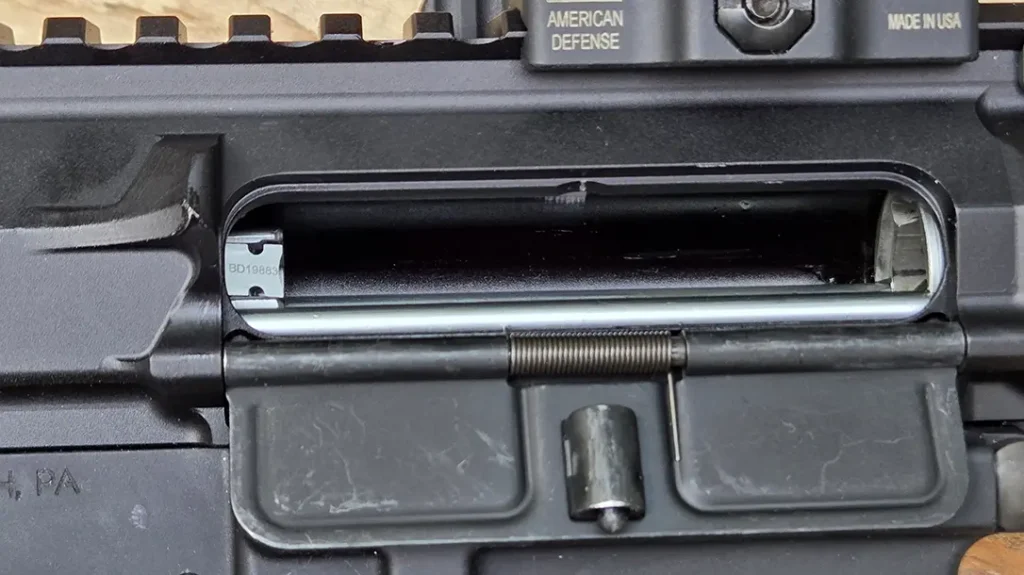
Recoil Impulse
The recoil impulse was interesting. Muzzle rise was basically nonexistent, and recoil was negligible. While I don’t find blowback 9mm AR’s unpleasant, they do move. The MEAN felt more like shooting my .22 LR AR’s. It stayed level on target and made fast repeat shots easy. Smooth would be the word that comes to mind. I imagine the compensator helps with that as well.
For subsequent range trips I swapped out the T1 for a C&H ERD-1 Optic that I had on hand for testing. It proved to be a nice pair up with the MEAN upper. The optic locks solidly in place with four bolts and almost seems like a monolithic platform once installed. It has a circle dot reticle, unlike my Aimpoint’s simple dot only set up. Sight in was quick and easy.
For my next range trips I added in ammunition from Remington, Freedom Arms, and Wilson Combat. Loads ranged from 115-grain hollow points through 147-grain subsonic loads. Again, the MEAN fed all ammunition with no issues. I had no malfunctions over hundreds of rounds over three range sessions with the upper.
Ejection on the MEAN upper is extremely positive. It throws brass vigorously about 10 to 15 feet to the right, rear of the shooter. If you shoot right-handed this isn’t an issue. If you’re a lefty, or are practicing shooting from your offhand side, then you’re getting a face full of brass. My buddy is a lefty and found that out the hard way.
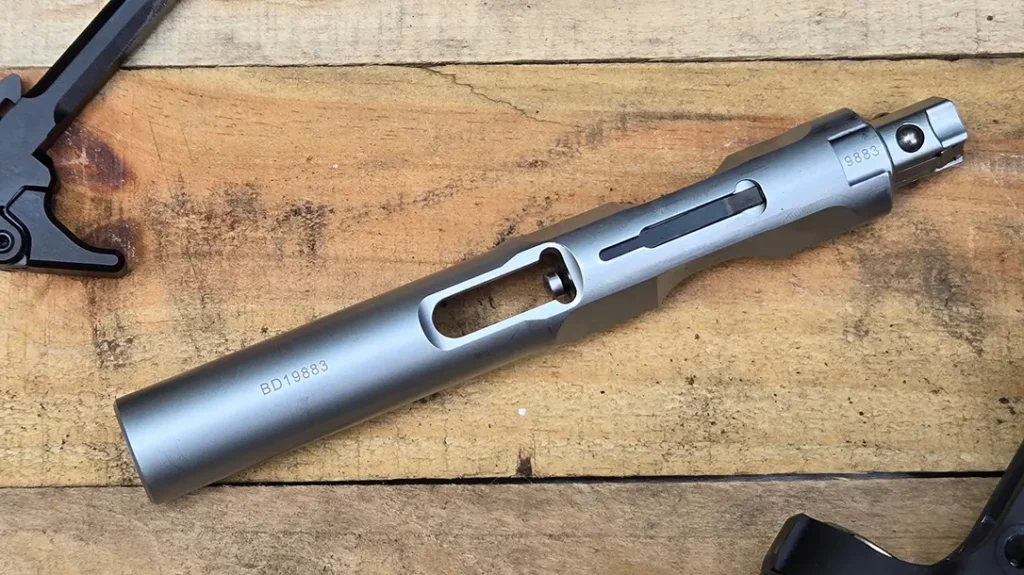
Punching Paper
On my last trip I actually sat down and put the MEAN on paper. I’ll be honest, I’d much rather shoot steel or reactive targets than punch paper. Although I knew the MEAN was accurate, I figured I’d better check and see what it could do.
I shot from a sandbag rest at 25 yards using the non-magnified C&H optic. I shot five-round groups, and did three, five-round groups of each load tested. Accuracy results are the best of the three series.
The winners were Wilson Defense 135-grain HBFP at 1 inch, the Remington 124-grain Golden Saber, also at 1 inch, and Lehigh Defense 118-grain ME +P carbine load at just ¾ inch. All three of these loads shot consistently into ragged one-hole groups. The other loads shot well, but I’d get an occasional flier opening them up some.
Round Up
The MEAN Bearing Delay Upper has a unique position in the crowded AR field. Its design makes for an accurate, and smooth shooting carbine. It’s worthwhile to consider using it for a dedicated 9mm build for those reasons alone. It can be paired up with a standard rifle lower and MEAN Exo mags, or a dedicated 9mm lower using the mags of your choice.
The conversion aspect is especially appealing though. The fact that you can just pop off your rifle’s upper, and drop the MEAN on, without changing anything else makes it extremely practical. If you’re doing so for training purposes, you have an easy swap to take advantage of inexpensive training ammunition and to allow for use on indoor ranges.
The MEAN Bearing Delay Upper has an MSRP of$1,400 to $1,500, depending on barrel length. It’s made in Georgia and comes with a lifetime warranty.
For more info, visit meanarms.com.
Accuracy Results
| Load | Group Size |
| Freedom Arms 115-grain RN FMJ | 3/4″ |
| Freedom Arms 124-grain HP | 2 3/8″ |
| Lehigh Defense 118-grain ME +P | 3/4″ |
| Remington UMC 115-grain FMJ | 2 1/2″ |
| Remington Golden Saber 124-grain BJHP | 1″ |
| Wilson Defense 135-grain HBFP | 1″ |
| Wilson Defense 125-grain HAP | 1 3/8″ |
| Wilson Defense 147-grain RN | 2 1/4″ |
